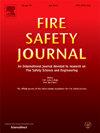在窄通道装置中,在不同的流速和环境压力下,相对火焰在热薄炭化材料上蔓延
IF 3.4
3区 工程技术
Q2 ENGINEERING, CIVIL
引用次数: 0
摘要
研究了在不同流速和环境压力条件下,受约束浮力作用下的对向火焰在热薄滤纸上的扩散,这将有助于地面微重力模拟技术的发展。随着流速的增加,可大致划分为三种状态:1)在接近淬灭状态时,由于缺氧而出现周期性指状小火焰,可燃性范围扩大;2)稳态蔓延状态下,由于浮力抑制,试样表面出现对称火焰,火焰蔓延速度达到峰值;3)在吹灭状态下,火焰受有限化学动力学影响。整个热解区被划分为以蓝色/橙色附着火焰为特征的一次/二次热解区,两者之间的频繁变换加剧了火焰的不稳定性。随着流速的增大,整体等效比在高压下先增大后减小,在低压下单调减小。窄通道装置抑制浮力效应的最佳利用应位于远离消光极限的中等流速范围内,在此范围内平行板的热损失效应可以忽略不计。通过对消光极限的跟踪,得到了不同压力下的可燃性边界。研究发现,淬火边界取决于燃料蒸气的扩散速率,而吹出边界由临界全局等效比决定。可燃性范围随着压力的减小而变窄,为了在未来空间任务中获得更好的微重力模拟效果,需要相对较高的环境压力。本文章由计算机程序翻译,如有差异,请以英文原文为准。
Opposed flame spread over a thermally-thin charring material under varied flow velocities and ambient pressures in a narrow channel apparatus
The opposed flame spread over thermally-thin filter paper under constrained buoyancy at varied flow velocities and ambient pressures was investigated, which will be conducive to develop ground-based techniques for simulating microgravity. With increasing flow velocity, three regimes can be roughly identified: 1) near quenching regime, the periodic fingering flamelets appear for oxygen starvation, expanding the flammability range; 2) steady-state spreading regime, symmetric flames occur among the sample surface due to buoyancy suppression, and the flame spread rate reaches its peak; 3) near blow-off regime, the flame is affected by finite chemical kinetics. The whole pyrolysis region is identified into the primary/secondary pyrolysis regions characterized by blue/orange attached flames, and the frequent transformation between them intensifies the flame instability. With increasing flow velocity, the global equivalence ratio increases firstly and decreases finally under higher pressures, while decreases monotonously under lower pressures. The optimal utilization of the narrow channel apparatus for suppressing the buoyancy effect should be located in the range of moderate flow velocities far away from the extinction limits, where the heat loss effect of the parallel plates can be neglected. By tracking the extinction limit, the flammability boundary under different pressures was obtained. It is found that the quenching boundary is dependent on the diffusion rate of fuel vapor, while the blow-off boundary is determined by the critical global equivalence ratio. The flammability range narrows with the decreasing pressure, and relatively higher ambient pressure is required to achieve better effectiveness of simulating microgravity in future space missions.
求助全文
通过发布文献求助,成功后即可免费获取论文全文。
去求助
来源期刊

Fire Safety Journal
工程技术-材料科学:综合
CiteScore
5.70
自引率
9.70%
发文量
153
审稿时长
60 days
期刊介绍:
Fire Safety Journal is the leading publication dealing with all aspects of fire safety engineering. Its scope is purposefully wide, as it is deemed important to encourage papers from all sources within this multidisciplinary subject, thus providing a forum for its further development as a distinct engineering discipline. This is an essential step towards gaining a status equal to that enjoyed by the other engineering disciplines.
 求助内容:
求助内容: 应助结果提醒方式:
应助结果提醒方式:


